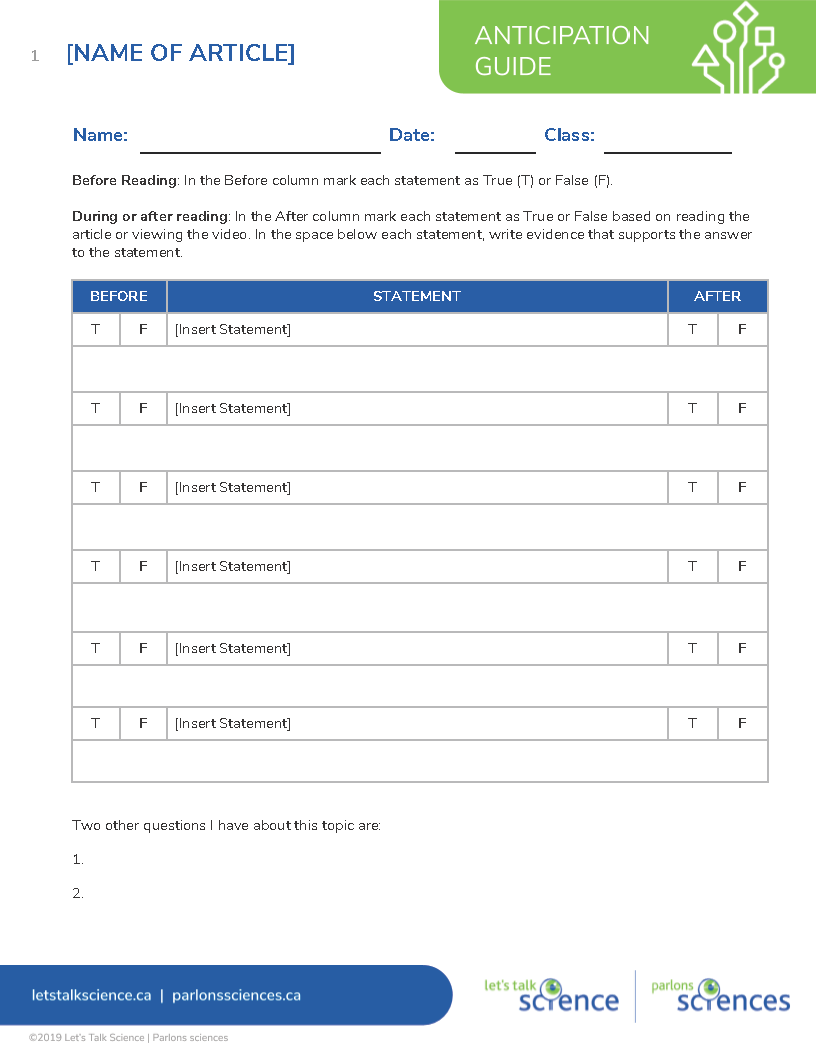Anticipation Guide

True or false (oatawa, iStockphoto)

True or false (oatawa, iStockphoto)
This strategy helps students access prior knowledge and challenge assumptions about a topic.
Why use it?
- To access and activate prior knowledge of the topic of a piece of written text or video
- To introduce a new topic from reading an article on the topic or viewing a video
- To build a student’s personal interest in the subject he/she will be reading about or seeing
- To establish a purpose for reading text/viewing a video (students read to gather information that will either confirm or dispute their initial beliefs and cause them to rethink their beliefs)
- To develop critical-thinking skills
Tips for success
- This strategy can work well with expository texts and/or videos that present ideas that may be controversial to the reader.
- Write a series of statements that focus on the information in the text/video footage that you want your students to focus on. Effective statements:
- Allow students to answer initially without having read the text or viewed the video.
- Can be clearly supported or refuted by information in the text or video.
- Challenge student’s beliefs and current level of understanding.
- Are general rather that specific.
How do I use it?
- Create questions for the Anticipation Guide based on a given article or video, or use one of the Ready-to-Use Anticipation Guides created for Let's Talk Science content (see right).

- Provide students with an Anticipation Guide at the beginning of the class.
- Students complete the first part of the Anticipation Guide activity before they read the selected article or view the selected video.
- Students answer answer the questions by marking a true or false (T/F) in the Before column of the Anticipation Guide.
- Once students have answered the questions, they they read the article or view the video.
- After reading or viewing , students mark true or false (T/F) in the After column of the Anticipation Guide.
- Students find and write evidence from the article or video that supports their thinking, using the space below each statement.
- Once completed these Anticipation Guides can be used in a variety of ways:
- Handed in to the teacher to provide a formative assessment prior to starting studies about the topic featured in the article or video.
- Students pair up and share their responses with their partner and discuss their responses.
- Have a class discussion on the responses and the information presented in the article or video.
Variations
- Model how to fill out an Anticipation Guide and find evidence in a text or video by completing an Anticipation Guide on an overhead or white board with the class.
- Have students develop their own Anticipation Guide questions based on a reading or video. These student-developed Anticipation Guides can be shared with other students.
Extensions
- Have students do additional external research to support or refute the claims and information in the article or video.
Using this Strategy
Anticipation Guide Reproducible Template [Google doc] [PDF]
Anticipation Guide-Reproducible - Eye vs. Camera [Google doc] [PDF] Answer Key [Google doc] [PDF]
Anticipation Guide-Reproducible - Pollinators [Google doc] [PDF] Answer Key [Google doc] [PDF]
Anticipation Guide-Reproducible - Should We Eat Bugs? [Google doc] [PDF] Answer Key [Google doc] [PDF]
Anticipation Guide-Reproducible - The Ins and Outs of the Rocky Planets [Google doc] [PDF] Answer Key [Google doc] [PDF]
Anticipation Guide-Reproducible - The Newest Elements on the Periodic Table [Google doc] [PDF] Answer Key [Google doc] [PDF]
Anticipation Guide-Reproducible - Careers In Sustainability [Google doc] [PDF] Answer Key [Google doc] [PDF]
Create Your Own
Anticipation Guide Reproducible Template [Google doc] [PDF]
Ready To Use
Anticipation Guide-Reproducible - Eye vs. Camera [Google doc] [PDF] Answer Key [Google doc] [PDF]
Anticipation Guide-Reproducible - Pollinators [Google doc] [PDF] Answer Key [Google doc] [PDF]
Anticipation Guide-Reproducible - Should We Eat Bugs? [Google doc] [PDF] Answer Key [Google doc] [PDF]
Anticipation Guide-Reproducible - The Ins and Outs of the Rocky Planets [Google doc] [PDF] Answer Key [Google doc] [PDF]
Anticipation Guide-Reproducible - The Newest Elements on the Periodic Table [Google doc] [PDF] Answer Key [Google doc] [PDF]
Anticipation Guide-Reproducible - Careers In Sustainability [Google doc] [PDF] Answer Key [Google doc] [PDF]
References
Allen, J. (2004). Tools for teaching content literacy. Stenhouse Publishers.
Toronto District School Board. (2004). Instructional strategies for making connections in science (grades 9-12). Toronto District School Board.
University of Idaho, Education. (2011). Literacy instruction in mathematics and science for secondary teachers.